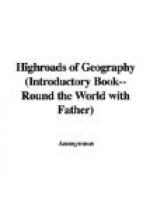Lesson 17.
1. What is the difference between Burmese football and British football?
2. Describe the picture on page 68 {Illustration of boys playing Burmese football}.
3. Write out the following: “Rice is a grass on which many seeds grow. These seeds are eaten. Rice will only grow in wet ground. The fields are flooded with water, and then the rice-shoots are planted. The fields must be kept flooded until the rice is ripe. In India, men sometimes gather the rice in small boats.”
Lesson 18.
[Illustration: {Rickshaw}]
1. Copy this little drawing of a rickshaw.
2. Write out the following: “Tea is the name given to the dried leaves and young shoots of the tea-plant. This plant is a large evergreen shrub. It grows on the hillsides of Ceylon, and in many other places in the East. When the leaves are picked, they are spread out in trays until they wither; then they are rolled. Wet cloths are next placed over the leaves, and they are put in a cool dark place, until they rot a little. The leaves are then dried over a fire, and after cooling are packed in air-tight chests. They are then sent to our country.”
3. Describe the picture on page 75 {Illustration entitled “Ceylon Girls Playing the Tom-Tom"}.
Lesson 19.
1. Old cities have walls round them. Why were these walls built? Why are they of no use now?
[Illustration: {Chinese wheelbarrow}]
2. Copy this drawing of a Chinese wheelbarrow.
3. Why do the Chinese paint an eye on the bows of their boats?
Lesson 20.
1. Describe the picture on page 78 {Illustration entitled “A Chinese Street"}.
2. Say what you know about a Chinese school.
3. How can you tell a Chinaman when you see him?
Lesson 21.
1. Describe the picture on page 88 {Illustration entitled “A Rich Chinaman’s House"}.
2. In what ways do Chinese girls differ from British girls?
3. Write out the following: “The Great Wall of China is the longest wall in the world. It was built about two thousand years ago, and was meant to shut out the wild tribes which were then trying to conquer China. The wall is more than twice as long as the island of Great Britain. It is built of stone and earth, and is so broad that four horses can be driven on it abreast. The wall is now in ruins.”
Lesson 22.
1. Write out and learn: An island is land with water all round it. People can only reach an island by sailing to it in a boat or by crossing a bridge. A small island is called an islet.
2. Model an island in clay or plasticine. Suppose the water round an island were to dry up, what would the island be then?
[Illustration: {Snow-covered mountain}]
3. Copy this little drawing. It shows you the sacred mountain of Japan.




